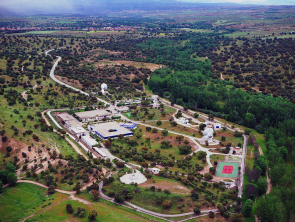RSGS: The Rosetta Science Ground Segment
 |
|
Rosetta SGS is based at the European Space Astronomy Centre, ESAC, in Spain |
There are 11 instruments on board the Rosetta orbiter. Each was provided and is administered by teams from institutes across the world. The suite of instruments comprises cameras, spectrometers, magnetometers, and sensors, and each has its own specific needs that must be balanced to maximize the overall science return.
As a general rule, the instruments that collect gas and dust usually want to point directly down at the nucleus of the comet. These include COSIMA, GIADA, MIDAS, and ROSINA. The RPC instrument, a collection of in-situ plasma and wave sensors, also has specific pointing requirements.
The remote-sensing experiments are more varied. Depending upon the investigation, they sometimes want to point straight down at the nucleus, sometimes at the limb, sometimes out towards the coma - the gas and dust environment surrounding the nucleus. Alice, OSIRIS, MIRO, and VIRTIS are like this.
Not fitting directly into these classifications are RSI and CONSERT. RSI uses the high gain antenna of the spacecraft directly for its science, so any pointing constraints are dictated by the spacecraft operations. The CONSERT experiment comprises a radio antenna on the lander and one on the orbiter, to perform tomography of the comet nucleus. Science operations with CONSERT require the transmission of radio signals between these antennae, through the body of the comet.
To allow all of these instruments to reach their individual science goals, the science ground segment is split into different groups to focus on specific aspects.
Based on the high-level science goals of the mission, Liaison scientists work to combine all the different observation requests from the instrument teams. These include information on where they would like their instrument to be pointed, and for how long. The liaison scientist must resolve any conflicts in the requests. Solutions can include one set of instruments being prioritised for a particular period, or the spacecraft pointing can be changed during the orbit.
Once the liaison scientists have consolidated the requests into a workable timeline, they pass this to the Operations Planning group. This group is in charge of implementing the timeline by turning it into spacecraft commands. They make sure that the requests do not cause Rosetta to operate in a manner that could be dangerous, for example: to lose power by turning its solar panels away from the Sun, or point an instrument too close to the Sun, which could destroy sensitive optics.
A Software Support group provides planning and simulation software that allows many of the SGS procedures to be automated.
The SGS also have a Trajectory Planning and Simulation group that will determine the paths Rosetta takes around the comet. Up to the landing of Philae in November, the flight operations team at the European Spacecraft Operations Centre (ESOC), Germany, will determine the trajectory of Rosetta. After that, the job will transfer to the SGS, who devise a trajectory appropriate for the science operations for a given period. This is then sent to ESOC for implementation.
The overall SGS planning is supported initially by a NASA/JPL-developed software called ASPEN, which serves to identify (at a very high level) the resource and pointing feasibility for instruments for the period in question (nominally three months). With this as input, the detailed final planning at pointing and command level, which includes iterations with the instrument teams, is carried out using extensions of a software package, MAPPS, developed together with ESA's Directorate of Technical and Quality Management and earlier used for Mars Express and Venus Express.
By early 2015, the comet may become so active that it will be difficult for Rosetta to stay in orbit. This is because the comet's gravity is so weak that the pressure of the gases coming off the comet will push the spacecraft away. Instead, Rosetta will perform a continual series of fly-bys. Each of these trajectories will be provided to the liaison scientists, so that they can match them to the science requests from the instrument teams.
When the instruments send back their data, they also send back their telemetry. This tells the SGS how successful the instruments have been in taking the observations. If there is a problem, this is identified by the SGS Observation Quick Look Software, which performs a variety of engineering quality checks on the data provided by the instruments. At this point the SGS must begin a dialogue with the instrument team to diagnose the problem and assess its impact on the mission and the science objectives.
Finally, the SGS is also in charge of the data archive. Although the nominal Rosetta mission will end at the end of 2015, the legacy of the mission must continue. That legacy will be primarily in the form of a data archive that will be made available to all, on the internet. This will be delivered via the ESA Planetary Science Archive and the NASA Planetary Data System.

